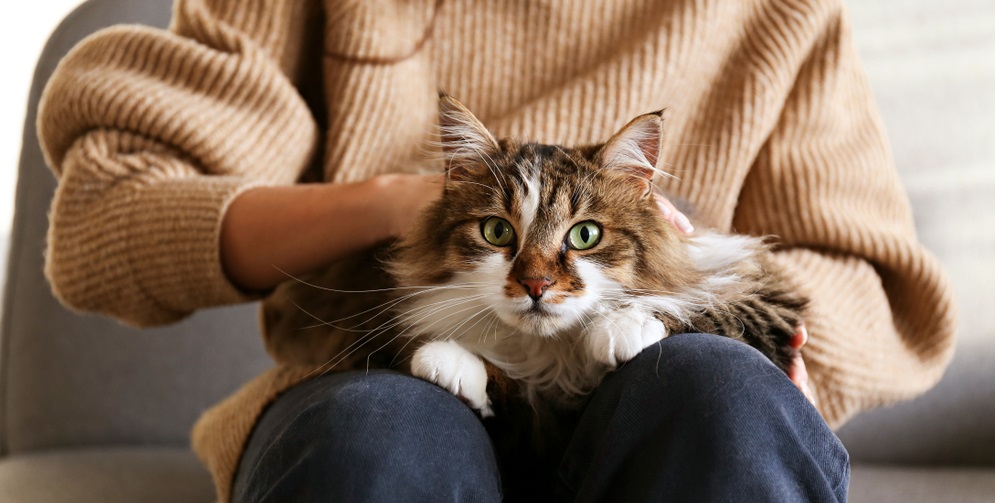Is there anything more rewarding than the feeling you get from watching your cat stretch, smile, and pur as you scratch beneath their chin or behind their ears? You may even be lucky enough to sneak in a few belly rubs from time to time.
To scratch an itch is one of life’s simple pleasures for both humans and animals alike. However, if your cat is struggling with skin irritation or pain, they may not know when to stop scratching. Excessive scratching can create an open wound, leading to hot spots that turn a simple pleasure into a painful skin infection.
Keep reading to learn more about what causes hot spots in cats, and how you can detect, treat, and prevent future hot spots for your furry friend.
The Root of the Problem
Hot spots in cats (also known as pyotraumatic dermatitis or acute moist dermatitis) are often caused when a cat exacerbates an itchy or sore area of their body by biting or licking at the area until the skin becomes irritated and infected.1
The resulting wound is referred to as a hot spot because the cat’s immune response causes the area to become hot to the touch.2
There are a variety of irritants that may cause cats to excessively scratch or bite at themselves, including:3
- Environmental allergens – Environmental allergens can include naturally-occuring culprits such as pollen, dust mites, and mold, or irritants that make their way into your home through store-bought products, such as air fresheners or laundry detergent. If you’ve recently introduced a new product to your home or cat, stop using the product to see if your cat’s excessive scratching decreases. If your cat’s condition doesn’t improve, contact your veterinarian to discuss options for allergy testing and cat hot spot treatment.
- Food allergies – Introducing new food into your cat’s diet could be the source of their skin irritation and sensitivity. To identify a potential food allergy, discuss implementing a limited ingredient diet or specialized trial diet with your veterinarian.
- Improper grooming – If your cat’s fur isn’t regularly brushed, it can become knotted and tangled, creating painful, itchy matts. Not only do these thick matts interfere with the circulation of air to your cat’s skin, but they also create a dark, moist environment where bacteria can thrive, particularly during hot summer months. When a cat scratches excessively at matted fur and creates an open wound, the bacteria festering beneath the matted fur can enter the wound, resulting in infection.

To prevent matts and cat hot spots, be sure to brush your cat often and try to fit in regular claw trimmings. Shorter claws will cause less damage if your cat does get the urge to scratch an itch.
- Fleas – When a flea bites your cat, the flea saliva can trigger inflammation and itchiness, similar to the way your skin responds to a mosquito bite. To help keep your feline friend flea-free, ask your veterinarian about monthly flea treatments, and be sure to brush your cat regularly. With daily grooming, you’re more likely to spot fleas or flea dirt, which will appear as dark flecks on your cat’s skin.
- Pain – Older cats may suffer from arthritis or other aches that come with age. Oftentimes, biting or licking a painful spot is the only way cats know how to deal with the pain and discomfort.
- Boredom – If your cat isn’t getting the mental or physical stimulation they need, they may bite or scratch at their skin out of boredom. To prevent your cat from developing this habit, add extra playtime into your daily routine. This can include playing with a feather wand, hiding treats in a toy, or creating a kitty obstacle course out of cardboard boxes.
How Do You Know If Your Cat is Experiencing a Hot Spot?
Even if your cat can be expressive through their body language and vocalizations, understanding when they may be in pain can nevertheless be difficult.
Here are some signs your cat may be struggling with a hot spot:4
- Biting or licking – Biting or licking alone are not red flags, but if your cat is paying excessive attention to a specific area, it may be a sign of irritation or pain.
- Round sores – Excessive licking or scratching can cause lesions that may ooze pus or scab over, making the wound itchier than before. If your cat is unable to stop licking their sore, they may need to suffer the indignity of donning a cone (also known as an Elizabethan collar).
- Hair loss – Over time, consistent licking and biting can cause hair loss or fur discoloration around the wound.
Treatment
Regardless of the underlying cause of your cat’s hot spots, treating the resulting injury is fairly easy and can be done in the comfort of your home by following a three-step process:
- Step 1: Clear the area – Trim the fur around the wound to allow yourself better access to the area. Because trimming can be painful or nerve wracking for your cat, be sure to take your time and work carefully, or ask a professional groomer to trim the area for you.
- Step 2: Clean the area – Disinfect the hot spot with either a saline solution or a feline safe-wound cleaner such as Vetericyn Plus® Antimicrobial All Animal Wound and Skin Care solution.
- Step 3: Protect the area – Apply a non-toxic product, such as Vetericyn Plus® Feline Antimicrobial Hydrogel, to prevent further infection and speed up the healing process. This non-irritating hydrogel adds an extra layer of protection which guards the area while keeping it moist to promote optimal healing.
Keep Your Feline Friend Happy, Healthy, and Itch-Free With Vetericyn
Dealing with pain is difficult enough without the added disadvantage of not being able to communicate it. Fortunately, by being vigilant about hot spot prevention and taking note of any changes in your cat’s behavior, you can help save your furry friend from the discomfort of itchy, irritated, and infected skin.
Plus, with Vetericyn on your side, you’re prepared in the event hot spots do develop. By using Vetericyn’s non-toxic Feline Antimicrobial Hydrogel at the first sign of a hot spot, you can quickly treat the wound, stop the itch, and help your cat get back to enjoying the simple pleasures in life. Noticing similar symptoms in your dog? Learn more about what a hot spot in dogs is, how to identify an infected hot spot on dogs and what causes hot spots on dogs in our latest blog posts.
For trusted, at-home animal wellness care, choose Vetericyn.
Sources:
- Veterinary Practice. Pyotraumatic dermatitis (acute moist dermatitis, hot spot). https://veterinary-practice.com/article/pyotraumatic-dermatitis-acute-moist-dermatitis-hot-spo
- Love to Know. Causes and Treatment of Feline Hot Spots. https://cats.lovetoknow.com/cat-health-health-problems/feline-hot-spots
- Pet Companion Magazine. Hot Spots on Cats. https://www.petcompanionmag.com/hot-spots-on-cats/
- Litter-Robot. Hot Spots on Cats: Causes and Treatments. https://www.litter-robot.com/blog/2020/06/15/hot-spots-on-cats/
